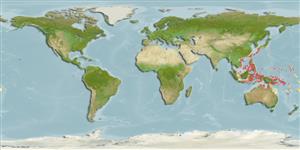Actinopterygii (ray-finned fishes) >
Perciformes (Perch-likes) >
Gobiidae (Gobies) > Gobiinae
Etymology: Amblygobius: Greek, amblys = darkness + Latin gobius = gudgeon (Ref. 45335). More on author: Herre.
Environment / Climate / Range
Ecology
Marine; reef-associated; depth range 1 - 10 m (Ref. 86942). Tropical, preferred ?
Western Central Pacific: Iriomotejima and the Philippines; also from West New Guinea.
Size / Weight / Age
Maturity: Lm ? range ? - ? cm
Max length : 6.5 cm TL male/unsexed; (Ref. 90102)
Dorsal
spines
(total): 6 - 7;
Dorsal
soft rays
(total): 13;
Anal
spines: 1;
Anal
soft rays: 12. Characterized by generally whitish body color with three black stripes on upper two-thirds of head and body; presence of diffuse narrow bars on side; first and second dorsal fin equal in height; rounded caudal fin; longitudinal scale series 60; fully scaled predorsal region; scales dorsally on opercle, absent on cheek; ctenoid body scales; cycloid scales on nape, abdomen, and opercle; depth of body 4.5-4.8 in SL (Ref. 90102).
Occurs on silty mud flats among the aerial roots of mangroves (Ref. 37816). Also found in stream mouths or occasionally in saline lakes in 0-3 m (Ref. 90102). Max. length (Edward O. Murdy, pers. comm., 1998).
Life cycle and mating behavior
Maturity | Reproduction | Spawning | Eggs | Fecundity | Larvae
Masuda, H., K. Amaoka, C. Araga, T. Uyeno and T. Yoshino, 1984. The fishes of the Japanese Archipelago. Vol. 1. Tokai University Press, Tokyo, Japan. 437 p. (text). (Ref. 559)
IUCN Red List Status (Ref. 115185)
CITES (Ref. 94142)
Not Evaluated
Threat to humans
Harmless
Human uses
More information
Common namesSynonymsMetabolismPredatorsEcotoxicologyReproductionMaturitySpawningFecundityEggsEgg development
ReferencesAquacultureAquaculture profileStrainsGeneticsAllele frequenciesHeritabilityDiseasesProcessingMass conversion
Tools
Special reports
Download XML
Internet sources
